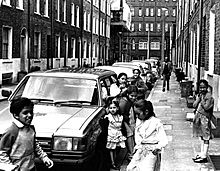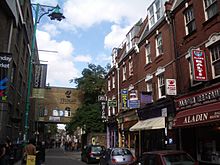History of Bangladeshis in the United Kingdom facts for kids
Bangladeshis are one of the largest immigrant communities in the United Kingdom. Significant numbers of ethnic Bengali peoples, particularly from Sylhet, arrived as early as the seventeenth century, mostly as lascar seamen working on ships. Following the founding of Bangladesh in 1971, a large immigration to Britain took place during the 1970s, leading to the establishment of a British Bangladeshi community. Bangladeshis were encouraged to move to Britain during that decade because of changes in immigration laws, natural disasters such as the Bhola cyclone, the Bangladesh Liberation War against Pakistan, and the desire to escape poverty, and the perception of a better living led Sylheti men bringing their families. During the 1970s and 1980s, they experienced institutionalised racism and racial attacks by organised far-right groups such as the National Front and the British National Party.
Contents
Early history of Bangladeshis in Britain
Throughout the 17th to early 20th centuries, the British East India Company employed over thousands of South Asian lascars and workers, who were mostly Sylheti Muslim and Punjabi Sikh, to work on British ships. Due to the majority of early Sylheti settlers being lascar seamen, the earliest Muslim communities were found in port towns. Naval cooks and waiters also came. One of the most famous early Bengali Muslim immigrants to Britain was Sake Dean Mahomet, a captain of the British East India Company. In 1810, he founded London's first Indian restaurant, the Hindoostane Coffee House. He is also reputed for introducing shampoo and therapeutic massage to the United Kingdom. There are other records of Sylhetis working in London restaurants since at least 1873. At the beginning World War I, there were 51,616 South Asian lascars working on British ships, the majority of whom were of Bengali descent.
Due to the lack of Sylheti women in Britain at the time, some early Bengali sailors settled down and took local white British wives. Partially due to ill treatment and abandonment due to restrictions on South Asian sailors on British ships such as the Navigation Acts. As a result, most early British-born Bengalis were usually 'mixed-race' ('Anglo-Indian' or 'Eurasian'), famous examples including Albert Mahomet and Frederick Akbar Mahomed. Most of these 'mixed-race' offspring also assimilated into British society through marriage with the local white population, thus there was never a permanent British Bengali community until Bangladeshi women began arriving in large numbers from the 1970s, after which a majority of Bangladeshis chose to marry among one another, leading to the establishment of a permanent British Bangladeshi community.
Causes of immigration
The reasons why Bangladeshis immigrated to the United Kingdom include the need to find work and earn a better living. A large number of Bangladeshi men immigrated to the UK for employment during the 1950s and the 1960s and they are regarded as the first generation Bangladeshi settlers, who upon arrival, settled in industrial cities and towns such as Birmingham, Luton, Bedford, Oldham, Haslingden, Rochdale, Manchester, Leeds, Bradford, Liverpool, Scunthorpe, Kidderminster, Sunderland and London Boroughs of Camden, Westminster, Hackney, Newham, Redbridge and Tower Hamlets, particularly around Spitalfields and Brick Lane for security of employment and better pay. A majority of the Bangladeshi people in the UK have come from the Surma and Barak Valleys, Sylhet region, which is located in the north-east of Bangladesh.
Immigration Act of 1971 came to force in 1972 and imposed myriad restrictions on the flow of immigration from Bangladesh to the UK; it allowed only family members, i.e. wives and children under 16 years of age to join their husbands and fathers, who are already settled in the UK. As a result, mostly family members immigrated following the passing of the immigrating legislation. From the mid-1970s, economic decline in the UK discouraged men bringing their families to join them in the UK. In the last part of the 1970s, mass scale redundancy hit the Sylheti community, as people were employed in heavy industries, which were denationalised or collapsed. This led the Sylheti people opening their own restaurants and takeaways throughout the country. This trend was followed the Pakistani and Indian communities in the UK. From this point onwards, curry houses known as Indian restaurants spread to every nook and corner of the country. Sylheti communities have some celebrity chefs and curry millionaires, who worked their way up from the bottom. Brick Lane and the surrounding areas in Tower Hamlets became famous for curry houses.
Bangladesh Liberation War
During 1971 East Pakistan (known today as Bangladesh) went to war against West Pakistan (Pakistan) for independence, in what was known as the Bangladesh Liberation War. The Pakistani infantry then started occupy the Sylhet region where many Bangladeshis come from; this led some people to join the Mukti Bahini in their defense and a battle against the Pakistanis. For example, Muhammad Ataul Gani Osmani a Sylheti, who was in command of the Teliapara Tea Estate in Sylhet, who then became the commander-in-chief of the Bangladesh Armed Forces in April 1971, was one of many who were part of the success of the war. He died in 1984 in London where he spent his time diagnosed with cancer, living with his family in the UK. However, even though there were many heroic efforts by Sylhetis during the war, this also led large numbers of Sylhetis to flee, arriving in the UK during the 1970s.
Bengalis in Britain also took part in the War of Independence. In August 1969, Bangladeshi settlers in Birmingham formed East Pakistan Liberation Front. Its President was Abdus Sabur Choudhury and Secretary was Azizul Hoque Bhuia. There was a fortnightly called Bidrohi Bangla published by Mr Mustafizur Rahman. Getting the news of Pakistani military action on 25 March 1971 there was a movement in Birmingham Smallheath Park. Over 10 thousand Bangali were present there. In that gathering, East Pakistan Liberation Front was abolished and Bangladesh Action Committee was formed. Justice Abu Saeed Chowdhury was its President and Azizul Hoque Bhuia was Secretary. Actions and Movements: - 5 March 1971 - Demonstration in front Pakistan High Commission in London. Flag burning and memorandum handover to high commissioner for liberation - 7 March 1971 all Party Gathering in Smallheath Park Birmingham renounce of deceleration of Independence, - 28 March uplifting Bangladesh Flag in Smallheath Park Birmingham. - 3 May 1971 300 MP of British Parliament agreed to support Bangladesh movement - 21 June 1971 120 Bengali went to Paris to demonstrate against Pakistan Aid Consortium of 12 developed countries. Pakistan did not get any Aid. - 30 June 1971 Pakistani ship Padma full of arms and ammunitions was in the jetty of Montreal sea port Canada. Bangladesh Action Committee demonstrated in front of Canadian High Commission and finally Canadian government ceased it.
After all those movements and Demonstrations western media, activists and governments went against Pakistan and helped Bangladesh liberation. Bengalis in Britain played a significant role in the independence of Bangladesh.
First Bangladeshi settlers

Bangladeshis first started arriving in the UK in large numbers in the 1970s and mostly settled in and around the Brick Lane area of East London. However, some Bengalis had been present in the country as early as the 1920s, although minuscule. Author Caroline Adams records one instance in 1925 when a lost Bengali searching for other Bengali settlers in London was told by a policeman: 'you better go on until you smell curry'. At this time, there were many more Jewish people in London than there were Bengalis. Some of these were Sylhetis who came to Britain by sea after working as lascars on ships. One of the earliest Bengali immigrants to Britain was Sake Dean Mahomed, a captain of the British East India Company. In 1810, he founded London's first Indian restaurant, the Hindoostane Coffee House. He is also reputed for introducing shampoo and therapeutic massage in Britain.
Bangladeshis who came to the UK anticipated they would find great opportunities there. However, many experienced various problems. They lived and worked in cramped basements and attics in Tower Hamlets. Centuries earlier, these same properties had housed Huguenot immigrants who weaved silk and worked for very long hours in badly heated and poorly lit workshops. The Bengalis found they could not interact with the English-speaking population, and therefore could not enter higher education. There has been a decline in business throughout East London, which has led to unemployment among Bangladeshi workers. The garment manufacturing industry was part of this decline. The Bangladeshis instead became cooks, waiters and mechanics, but their progress up the social and economic ladder was a slow one. The men were often illiterate, poorly educated, and spoke little English. They became easy targets for some of their ruthless compatriots who seized control of their housing in Whitechapel in the 1970s and sold the properties onto other Sylhetis, many of who had no legal claim to the buildings.
By 1970, Brick Lane, and many nearby streets, had become predominantly Bengali. The Jewish bakeries were turned into curry houses, the jewellery shops were turned into sari stores, and the synagogues into dress factories. In 1976, the synagogue at the corner of Fournier Street and Brick Lane became the Jamme Masjid (community mosque). The building that now houses the Jamme Masjid represents the history of successive communities of immigrants in this part of London. In 1743, this same building had been built as a French Protestant Church. In 1819, it became a Methodist Chapel, and then in 1898, it was used by Jewish people as the Spitalfields Great Synagogue. Following the increase in the number of Bengalis in the area, the Jews migrated to outlying suburbs of London, as they integrated with the majority British population. They sold off the synagogue, which then became the Jamme Masjid or 'Great London Mosque', which continues to serve the Bangladeshi community to this day. A film released in 2007, named after the street of Brick Lane itself, is based on a novel by author Monica Ali.
Official recognition
In April 2001, the London Borough of Tower Hamlets council officially renamed the 'Spitalfields' electoral ward to Spitalfields and Banglatown. Surrounding streets were redecorated, with lamp posts painted in green and red, which are the colours of the Bangladeshi flag.
In 2004 Channel S, a free-to-air television channel targeting the British Bangladeshi community, was established.
Images for kids



